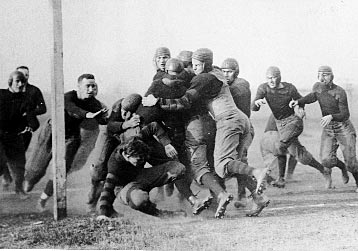
But, around 1920, the development of prelacing was an even greater improvement.

Eventually, metal stem valves like those on automobile tires were replaced with less dangerous rubber valves. With it, a football could be inflated in 5 minutes. In 1886, the Peck & Snyder Sporting Goods catalog offered a syringe-like device that was called, appropriately, the New Patent Foot Ball Inflator. Over time, inflating the ball became easier, but retaining the air did not. The players took turns blowing up the ball. Play had to be stopped several times, and a key that unlocked the small nozzle tucked inside the ball had to be brought in. In fact, during the second game between Rutgers and Princeton University in 1869, the ball kept deflating and losing its shape. The air continuously leaked out of the rubber bladder inside the ball. Leak Woesĭespite the contemporization of the game, there was still a big problem that had plagued football manufacturers for 50 years. And, in the 1930s, the Spalding J5-V began to be known as “The Duke,” which was the boyhood nickname of Wellington Mara, owner of the New York Giants. In 1922, the league was renamed the National Football League.
#FLYING WEDGE FOOTBALL INFLUENCE PROFESSIONAL#
In 1920, 28 years after William “Pudge” Heffelfinger became the first professional football player, the American Professional Football Association was formed, and the Spalding J5-V was named the official ball of the league. Hard-running backs like Jim Thorpe of the Canton Bulldogs and Red Grange of the Chicago Bears were the big stars of the day. The dangerous “flying wedge,” which involved the ball carrier following a phalanx of blockers, became routine. Still, football remained a grab-it-and-run game.

The ball now weighed 14 to 15 ounces, its long axis was set between 28 and 28 1/2 inches, and its short axis (around the middle) between 22 1/2 and 23 inches. That year, a new set of rules for college football transformed the game ball from the watermelon-shaped ball to an oversize version of today’s modern football. But laterals and short flips were becoming more common. This new ball looked like a watermelon, and wasn’t much easier to handle. Then, in 1874, a rugby-type ball was used in a contest between McGill University Foot-Ball-Club and Harvard University Football Club. The ball used in this very first game was round, like a soccer ball, and it was tough to carry and awkward to throw. Today’s modern Wilson football is actually the product of more than a century of innovation, which all started at Rutgers University in New Jersey on November 6, 1869. After a thorough inspection for quality, the football is ready for the big game. The final (and vital) step is called “molding,” wherein nearly completed footballs are placed inside a pressurized chamber to get out any residual lumps, crinkles, or rough edges. Next, the inflation bladder is inserted into the ball and then it gets laced up. The four leather panels of the ball are sewn together from the inside, and then the ball undergoes a process called “turning,” in which it’s taken out of a steam machine (to make it pliable) and forcibly reversed by hand on a metal pole.


It all starts with cutting four panels from large pieces of cowhide (yes, cow-not pig). The process of making a large batch of footballs can take anywhere from 25 to 30 days, but Wentling clarifies that a single football (much like the NCAA GST football captured above) can actually be marched through the entire process in just 15 minutes. For the big game, the NFL also inserts sensors in the balls to measure game data in realtime. For 2023, for example, that means colors reminiscent of the Phoenix skyline. The ball isn’t designed with the typical NFL shield, but instead sports a special logo influenced by the Super Bowl’s host city. Each Super Bowl team will receive 108 game balls each, and Wilson will make an additional 12 kicking balls, meaning 228 footballs will be made for the Super Bowl specifically, says Wentling. But much like how the Super Bowl gets glitzed up with a stunning half-time show and high-quality commercials, the game ball also gets special attention.


 0 kommentar(er)
0 kommentar(er)
